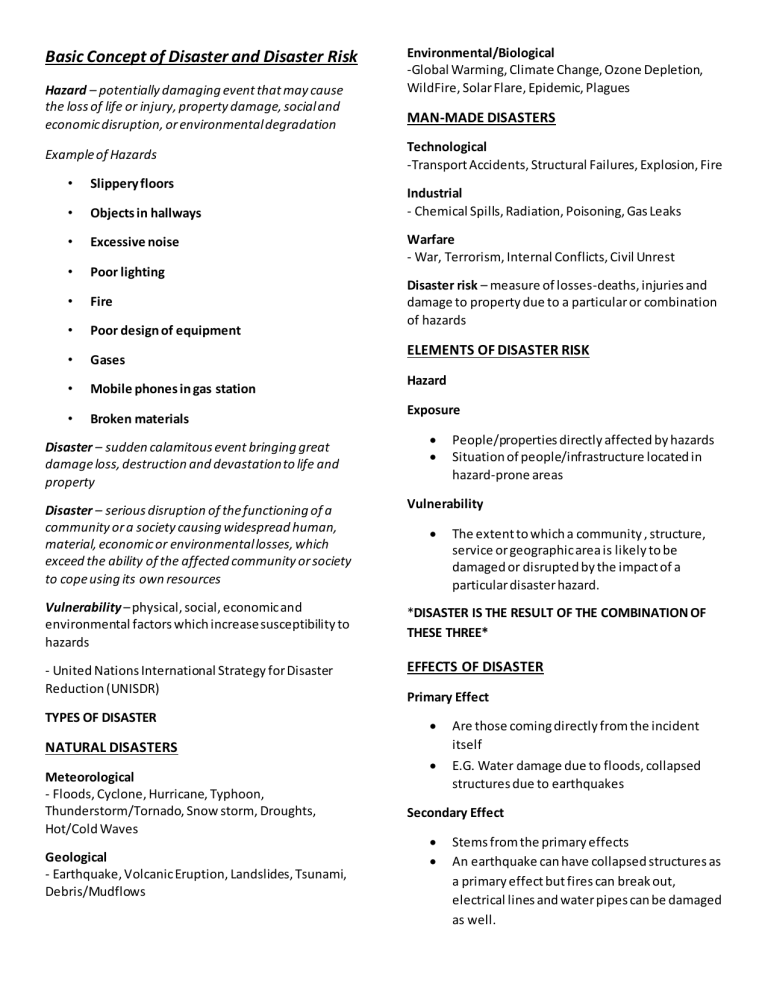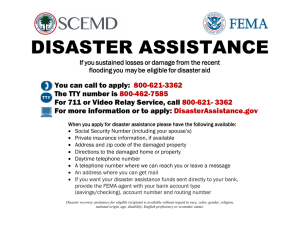
Basic Concept of Disaster and Disaster Risk Hazard – potentially damaging event that may cause the loss of life or injury, property damage, social and economic disruption, or environmental degradation Example of Hazards • Slippery floors • Objects in hallways • Excessive noise • Poor lighting • Fire • Poor design of equipment • Gases • Mobile phones in gas station • Broken materials Disaster – sudden calamitous event bringing great damage loss, destruction and devastation to life and property Environmental/Biological -Global Warming, Climate Change, Ozone Depletion, WildFire, Solar Flare, Epidemic, Plagues MAN-MADE DISASTERS Technological -Transport Accidents, Structural Failures, Explosion, Fire Industrial - Chemical Spills, Radiation, Poisoning, Gas Leaks Warfare - War, Terrorism, Internal Conflicts, Civil Unrest Disaster risk – measure of losses-deaths, injuries and damage to property due to a particular or combination of hazards ELEMENTS OF DISASTER RISK Hazard Exposure People/properties directly affected by hazards Situation of people/infrastructure located in hazard-prone areas Disaster – serious disruption of the functioning of a community or a society causing widespread human, material, economic or environmental losses, which exceed the ability of the affected community or society to cope using its own resources Vulnerability Vulnerability – physical, social, economic and environmental factors which increase susceptibility to hazards *DISASTER IS THE RESULT OF THE COMBINATION OF THESE THREE* - United Nations International Strategy for Disaster Reduction (UNISDR) EFFECTS OF DISASTER TYPES OF DISASTER NATURAL DISASTERS Meteorological - Floods, Cyclone, Hurricane, Typhoon, Thunderstorm/Tornado, Snow storm, Droughts, Hot/Cold Waves Geological - Earthquake, Volcanic Eruption, Landslides, Tsunami, Debris/Mudflows The extent to which a community , structure, service or geographic area is likely to be damaged or disrupted by the impact of a particular disaster hazard. Primary Effect Are those coming directly from the incident itself E.G. Water damage due to floods, collapsed structures due to earthquakes Secondary Effect Stems from the primary effects An earthquake can have collapsed structures as a primary effect but fires can break out, electrical lines and water pipes can be damaged as well. Fires can break out, electrical lines and water pipes can be damaged in a collapsed structure due to earthquakes Tertiary Effect Long term effect of hazard e.g. permanent relocation of a community due to an earthquake and reshaping of a river channel IMPACTS Medical Effects Damage to Critical Facilities Economic Impact Disruption of Transportation Psychological Effects global environmental change social and political impact




